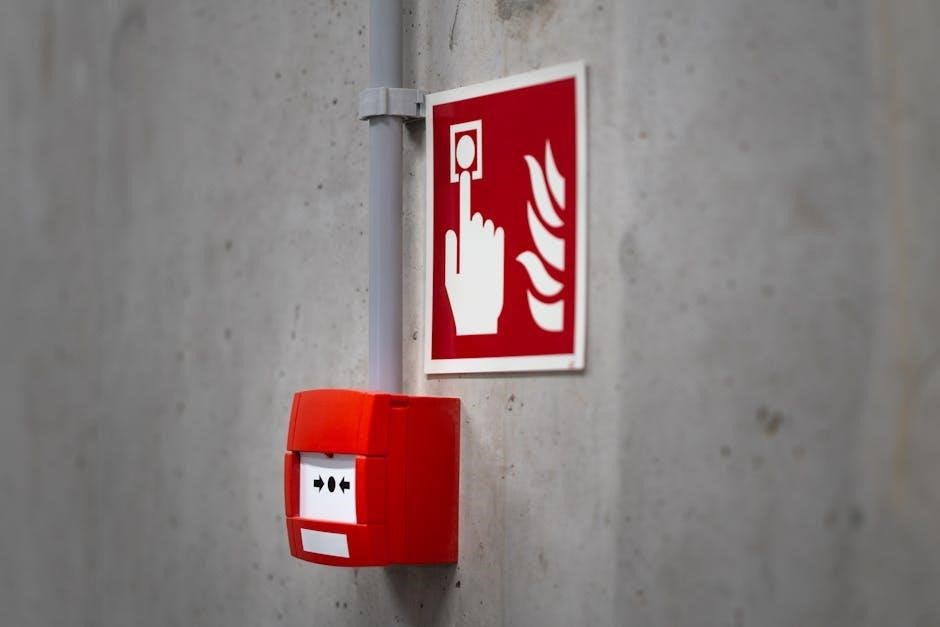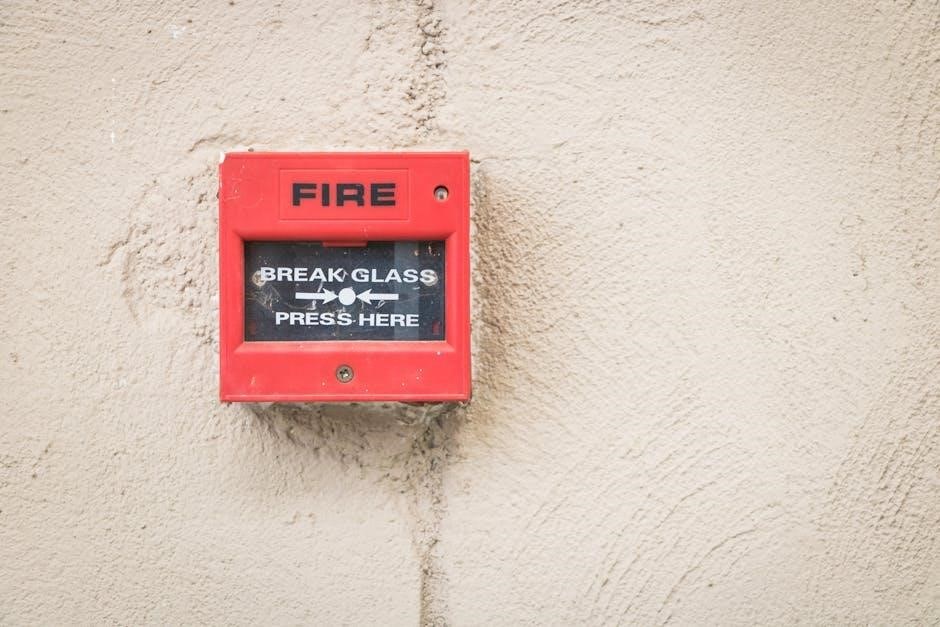how often should you test manual fire alarm call points
Manual fire alarm call points are essential for fire safety, enabling quick emergency responses. Regular testing ensures reliability and compliance with safety standards, safeguarding lives and property.
1.1 Importance of Manual Fire Alarm Call Points
Manual fire alarm call points are crucial for enabling quick responses to fires, ensuring the safety of occupants. They provide a reliable way to alert others in emergencies, complementing automatic detection systems. Regular testing is essential to verify functionality and compliance with safety standards, preventing potential failures during critical situations. Proper testing schedules, such as weekly checks, help maintain system reliability and ensure legal compliance, ultimately safeguarding lives and property from fire risks.
1.2 Purpose of Regular Testing
Regular testing of manual fire alarm call points ensures they function correctly during emergencies, safeguarding lives and property. It identifies faults early, preventing system failures when needed most. Testing verifies that all components, including mechanisms and wiring, operate reliably. Compliance with standards like BS 5839-1:2017 is maintained, ensuring legal requirements are met. Weekly tests help detect issues like faulty glass or signal failures, allowing prompt repairs. Consistent testing also minimizes false activations and ensures the system’s readiness, providing peace of mind and compliance with fire safety regulations. Proper documentation of tests further supports maintenance and accountability.

What Are Manual Fire Alarm Call Points?
Manual fire alarm call points are essential components of fire safety systems, enabling individuals to trigger alarms in emergencies. They are typically bright red, placed near exits, and designed for easy access to ensure quick activation during fires or other hazards. These devices are crucial for alerting building occupants and emergency services, ensuring timely evacuations and responses. Their visibility and accessibility make them vital for maintaining fire safety standards and preventing potential disasters. Regular testing and maintenance are required to ensure their reliability and effectiveness in critical situations;
2.1 Definition and Function
A manual fire alarm call point is a device that allows individuals to manually trigger a fire alarm in emergency situations. Typically bright red and located near exits or high-traffic areas, these points are designed for easy access. They function by activating the fire alarm system when operated, alerting occupants and emergency services to a potential fire hazard. Common types include break-glass call points, which require breaking a glass panel to activate, and push-button or resettable models. Their primary function is to ensure rapid notification and response, playing a critical role in fire safety and emergency evacuation procedures. Regular testing is essential to maintain their reliability and effectiveness in critical situations;
2.2 Types of Manual Call Points
Manual fire alarm call points come in various types, each designed to meet specific needs. The most common are break-glass call points, which require breaking a glass panel to activate the alarm. These are widely recognized and provide a clear visual indication of activation. Another type is resettable call points, which can be reused after testing or activation without replacing parts, offering convenience and cost savings. Additionally, some systems feature non-break glass models with buttons or levers, reducing accidental activation. Each type ensures reliable activation of the fire alarm system, contributing to overall fire safety and emergency preparedness.
2.3 Location and Accessibility
Manual fire alarm call points must be strategically located to ensure quick access in emergencies. They are typically placed near exits, staircases, and high-traffic areas, making them easily visible and reachable. Bright red in color, they stand out to grab attention swiftly. Installations are usually at a standard height to accommodate all individuals, including those with disabilities. Clear signage and unobstructed pathways further enhance accessibility. Proper placement ensures that anyone noticing a fire can activate the alarm without delay, reducing response time and enhancing overall safety. Their visibility and accessibility are crucial for effective fire safety management.

How Often Should Manual Fire Alarm Call Points Be Tested?
Manual fire alarm call points should be tested weekly, rotating different points each time to ensure all are checked over time, complying with British standards.
3.1 Weekly Testing Requirements
Weekly testing of manual fire alarm call points is essential to ensure system reliability. For smaller premises, testing one call point per week is sufficient. Larger sites may require testing two or three points weekly to cover all areas; The British Standard BS 5839-1:2017 recommends rotating call points each week to ensure comprehensive testing over time. This method guarantees that every call point is checked regularly, maintaining fire safety compliance and preventing system failures during emergencies. Regular testing also helps identify and address potential issues early, ensuring the alarm system functions correctly when needed.
3.2 Recommended Testing Frequency for Larger Premises
For larger premises, such as warehouses or extensive sites, testing multiple manual call points weekly is recommended. This ensures comprehensive coverage of the fire alarm system. The frequency should be adjusted based on the number of call points installed, ensuring that all are tested in rotation. For example, a system with 150 call points would require testing each one every 150 weeks. This rotational approach prevents wear and tear on individual units while maintaining system reliability. Regular testing ensures that all areas of the premises are protected and that the fire alarm system operates effectively in case of an emergency.
3.3 British Standard BS 5839-1:2017 Guidelines
British Standard BS 5839-1:2017 provides clear guidelines for the testing of manual fire alarm call points. It recommends that a different call point should be tested weekly to ensure all devices are checked in rotation. This rotational testing ensures that every call point is verified over time, with no maximum period specified for completing the cycle. The standard emphasizes the importance of regular testing to maintain system reliability and compliance with fire safety regulations. Proper documentation of test results is also required to demonstrate adherence to these guidelines and ensure legal compliance and building safety. This standard is crucial for maintaining fire safety integrity.

Step-by-Step Guide to Testing Manual Fire Alarm Call Points
Notify occupants, isolate the system, and use a test key to activate the call point. Observe the alarm response, record results, and reset the system afterward.
4.1 Pre-Test Procedures
Before testing, notify building occupants and management to avoid panic. Ensure the fire alarm system is in test mode to prevent false alerts to emergency services. Gather necessary tools like a call point test key and the fire alarm log book for documentation. Identify which call points to test, ideally rotating through all units to ensure comprehensive coverage. This preparation ensures a smooth and effective testing process without disrupting daily activities or triggering unnecessary alarms.
4.2 Using a Call Point Test Key
A call point test key is essential for simulating activation without damaging the unit. Insert the key into the designated slot and press gently to trigger the alarm. This method prevents glass breakage and ensures the call point remains intact. For non-resettable units, breaking the glass may be necessary, requiring a replacement. Always use the correct tool to avoid system damage and ensure accurate testing. This step verifies the call point’s functionality while maintaining its integrity for real emergencies.
4.3 Observing Alarm Activation
After activating the call point, observe the fire alarm system’s response. Ensure the control panel displays the activation and that the alarm sounds audibly throughout the premises. Verify that the signal is received and that no errors are indicated. For larger systems, check that the correct zone or call point is identified on the panel. This step confirms the system’s ability to alert occupants effectively. If the alarm does not activate or the panel shows a fault, further investigation is required. Proper observation ensures the call point functions as intended, providing reliable emergency alerts. Always document the results for compliance and maintenance records.
4.4 Recording Test Results
After testing, record the results in the fire alarm log book. Note the call points tested, the date, time, and whether they activated correctly. Document any faults or issues for repair. Accurate records ensure compliance with safety regulations and provide a history of system performance. This helps identify recurring problems and confirms that testing routines are being followed. Proper documentation also supports maintenance schedules and verifies system reliability. Always maintain detailed logs to demonstrate adherence to fire safety standards and legal requirements, ensuring accountability and preparedness in case of emergencies.
4.5 Resetting the Call Point and System
After testing, reset the call point and system to ensure normal operation. For break-glass points, replace the glass with a new one. Use a test key or tool to reset non-break mechanisms according to the manufacturer’s instructions. Resetting ensures the system is fully functional. Check the control panel to confirm the call point is no longer activated. If the system was in test mode, restore it to normal operation. Proper resetting prevents false alarms and maintains system readiness for emergencies. Always verify the system’s status after resetting to ensure reliability and safety compliance.

Common Issues During Testing
Common issues during testing include faulty glass or mechanisms, no signal at the control panel, and false activations. These can disrupt safety and require immediate attention.
5.1 Faulty Glass or Mechanism
Faulty glass or mechanisms in manual fire alarm call points can prevent proper activation. Break-glass points may have cracked glass or jammed triggers, while non-break-glass types might have faulty buttons or electrical issues. These problems can render the call point ineffective in emergencies. Regular testing helps identify such faults early, ensuring timely repairs. If damaged, glass should be replaced immediately, and mechanisms should be serviced by professionals. Neglecting these issues can lead to delayed emergency responses, compromising safety. Always prioritize prompt resolution to maintain system reliability and compliance with fire safety standards.
5.2 No Signal Received at the Control Panel
No signal at the control panel during testing indicates a potential issue with the call point or system wiring. This could stem from loose connections, damaged wires, or corrosion. If the control panel fails to register activation, the fire alarm system cannot alert occupants or emergency services. Testing each call point weekly helps identify such faults early. If a call point fails to signal, a qualified technician should investigate and repair or replace faulty components. Regular maintenance, including annual inspections, is crucial to prevent such issues and ensure reliable fire safety system performance.
5.3 False Activations
False activations occur when a manual call point is triggered accidentally or maliciously, leading to unnecessary alarms. This can disrupt operations and cause complacency among occupants. Regular testing helps identify call points prone to false activations, often due to damage or vandalism. Addressing these issues promptly is crucial to maintain system reliability and reduce disruptions. Ensuring call points are securely installed and protected from tampering can minimize false activations. Additionally, educating staff and occupants about the importance of fire safety systems can help prevent accidental triggers, ensuring the system remains effective in genuine emergencies.

Maintenance and Inspections
Regular maintenance and inspections are vital to ensure manual fire alarm call points function correctly. This includes routine checks and annual professional inspections to identify and address potential issues promptly.
6.1 Routine Maintenance Checks
Routine maintenance checks for manual fire alarm call points are crucial to ensure their reliability. These checks involve inspecting for damage, cleaning the unit, and verifying proper function. Weekly testing, as outlined in fire safety standards, helps identify issues early. Additionally, checking the integrity of glass or mechanisms and ensuring all components are free from dust or debris is essential. The British Standard BS 5839-1:2017 emphasizes the importance of regular maintenance to prevent system failures. Properly maintained call points reduce the risk of false activations and ensure timely emergency responses, safeguarding building occupants and complying with legal requirements. Regular checks also extend the lifespan of the system components.
6.2 Annual Inspections by Professionals
Annual inspections by professionals are critical for ensuring the optimal functionality of manual fire alarm call points. These inspections go beyond routine checks, involving detailed testing of all system components. Professionals will test each call point, verify wiring integrity, and ensure the control panel operates correctly. The British Standard BS 5839-1:2017 recommends these inspections to identify and address potential issues before they escalate. Annual checks also ensure compliance with fire safety regulations, reducing the risk of system failures during emergencies. Professional inspections provide a comprehensive assessment, ensuring the fire alarm system remains reliable and ready for emergency situations, safeguarding lives and property effectively. Regular professional oversight is vital for maintaining fire safety standards and preventing legal or financial repercussions from non-compliance.

Documentation and Legal Compliance
Keeping a fire alarm log book is essential for recording test results, faults, and repairs. Accurate documentation ensures compliance with fire safety regulations and avoids legal repercussions.

7.1 Keeping a Fire Alarm Log Book
A fire alarm log book is crucial for documenting all testing, maintenance, and repairs. It provides a clear record of compliance with fire safety regulations. Each test must be logged with details like the date, time, and results. This includes noting any faults or issues identified during testing. The log book also serves as evidence of adherence to legal requirements for fire safety. Regular updates ensure transparency and accountability, helping to identify recurring issues. Proper maintenance of the log book is essential for audits and inspections, ensuring your system meets safety standards and avoids legal penalties.
7.2 Legal Requirements for Testing
Legal requirements mandate regular testing of manual fire alarm call points to ensure compliance with fire safety standards. Under British Standards like BS 5839-1:2017, weekly testing is compulsory, with each call point tested in rotation. Failure to comply can result in legal penalties, fines, or invalidation of insurance coverage. The responsible person, such as a building owner or manager, must ensure tests are conducted and documented. Non-compliance not only risks safety but also legal consequences, emphasizing the importance of adhering to these regulations to protect lives and property while avoiding legal repercussions.

Consequences of Inadequate Testing
Inadequate testing of manual fire alarm call points poses significant safety risks, including system failures during emergencies. Legal penalties and financial losses may also result from non-compliance with regulations.
8.1 Safety Risks
Inadequate testing of manual fire alarm call points poses critical safety risks, potentially leading to system failures during emergencies. If call points malfunction, delays in emergency response can result in severe injuries or loss of life. Faulty systems may fail to alert occupants, allowing fires to spread uncontrollably. This negligence endangers everyone in the building, emphasizing the importance of regular testing to ensure reliable operation and timely evacuations; Without proper maintenance, the likelihood of tragic outcomes increases significantly, making consistent testing a vital safety measure.
8.2 Legal and Financial Implications
Failure to test manual fire alarm call points regularly can lead to legal consequences, including fines and penalties for non-compliance with fire safety regulations. Businesses may face lawsuits if inadequate systems result in property damage or personal harm. Additionally, insurance coverage could be invalidated, leaving organizations financially vulnerable. Legal requirements mandate regular testing, and neglecting these duties can damage an organization’s reputation and lead to financial losses. Compliance with testing standards is essential to avoid legal action and ensure financial protection in the event of a fire-related incident.

Best Practices for Testing
Adopt a systematic approach by rotating call points weekly to ensure comprehensive coverage. Minimize disruption by testing during low-activity periods and notifying occupants in advance.
9.1 Rotating Call Points for Testing
Rotating manual fire alarm call points ensures each device is tested over time, preventing wear and tear. For smaller premises, test one call point weekly, while larger sites may require testing multiple points. This method ensures all call points are checked systematically. British Standard BS 5839-1:2017 recommends testing a different call point each week to maintain reliability and compliance. Over time, this rotation ensures every call point is verified, preventing overlooked issues and ensuring all devices remain functional in emergencies.
9.2 Minimizing Disruption During Tests
To minimize disruption during fire alarm call point testing, notify occupants in advance to avoid panic. Use the system’s test mode to prevent full alarms from sounding. Test during low-traffic times, such as weekends or outside business hours. Employ test keys or tools to activate call points without triggering alarms. Ensure the system is fully reset post-testing to maintain functionality. Regular, scheduled testing helps avoid unexpected disruptions while ensuring compliance with safety regulations and maintaining a reliable fire alarm system.
Regular testing of manual fire alarm call points is crucial for ensuring safety and compliance. Adhering to schedules and maintaining systems prevents emergencies and legal issues, safeguarding lives and property effectively.
10.1 Summary of Key Points
Regular testing of manual fire alarm call points is essential for ensuring reliable fire safety systems. Weekly testing is recommended, with a different call point tested each week to ensure all devices are checked over time. Larger premises may require testing multiple points weekly, while smaller sites can test one. Compliance with British Standards like BS 5839-1:2017 is crucial for legal and safety requirements. Proper documentation and maintenance are vital to avoid system faults and ensure readiness in emergencies. Neglecting these practices can lead to safety risks and legal consequences, emphasizing the importance of consistent and thorough testing routines.
10.2 Final Thoughts on Fire Safety Compliance
Adhering to fire safety compliance is paramount for protecting lives and property. Regular testing of manual fire alarm call points ensures systems function reliably during emergencies. By following British Standards like BS 5839-1:2017, businesses maintain legal compliance and minimize risks. Consistent testing schedules, proper documentation, and professional inspections are critical. Neglecting these practices can lead to severe consequences, including safety hazards and legal penalties. Prioritizing fire safety compliance not only safeguards occupants but also upholds organizational responsibility, ensuring preparedness and peace of mind in the face of potential emergencies.
